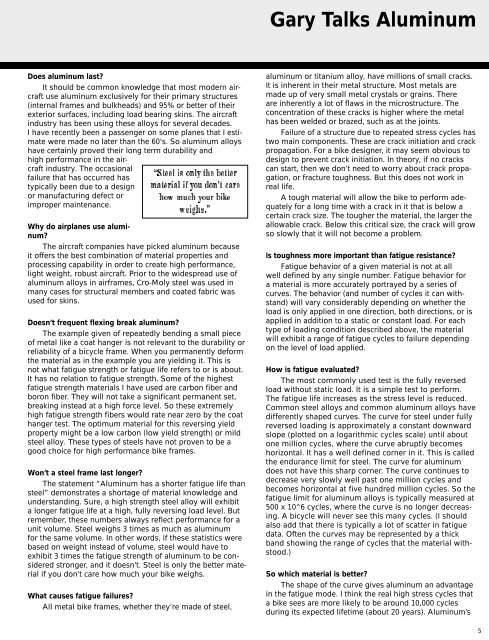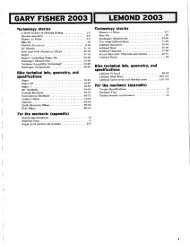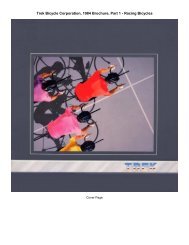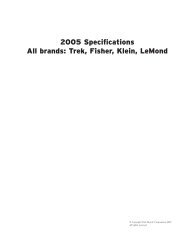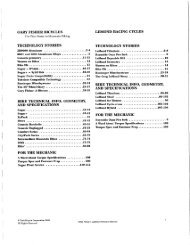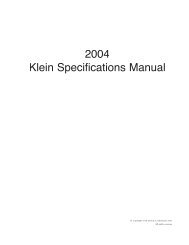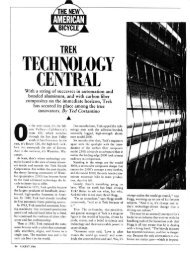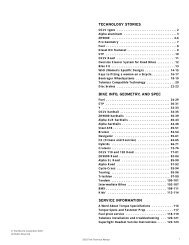2002 Klein Technical Manual - Vintage Trek
2002 Klein Technical Manual - Vintage Trek
2002 Klein Technical Manual - Vintage Trek
You also want an ePaper? Increase the reach of your titles
YUMPU automatically turns print PDFs into web optimized ePapers that Google loves.
Does aluminum last?<br />
It should be common knowledge that most modern aircraft<br />
use aluminum exclusively for their primary structures<br />
(internal frames and bulkheads) and 95% or better of their<br />
exterior surfaces, including load bearing skins. The aircraft<br />
industry has been using these alloys for several decades.<br />
I have recently been a passenger on some planes that I estimate<br />
were made no later than the 60's. So aluminum alloys<br />
have certainly proved their long term durability and<br />
high performance in the aircraft<br />
industry. The occasional “Steel is only the better<br />
failure that has occurred has<br />
typically been due to a design material if you don’t care<br />
or manufacturing defect or how much your bike<br />
improper maintenance.<br />
weighs.”<br />
Why do airplanes use aluminum?<br />
The aircraft companies have picked aluminum because<br />
it offers the best combination of material properties and<br />
processing capability in order to create high performance,<br />
light weight, robust aircraft. Prior to the widespread use of<br />
aluminum alloys in airframes, Cro-Moly steel was used in<br />
many cases for structural members and coated fabric was<br />
used for skins.<br />
Doesn’t frequent flexing break aluminum?<br />
The example given of repeatedly bending a small piece<br />
of metal like a coat hanger is not relevant to the durability or<br />
reliability of a bicycle frame. When you permanently deform<br />
the material as in the example you are yielding it. This is<br />
not what fatigue strength or fatigue life refers to or is about.<br />
It has no relation to fatigue strength. Some of the highest<br />
fatigue strength materials I have used are carbon fiber and<br />
boron fiber. They will not take a significant permanent set,<br />
breaking instead at a high force level. So these extremely<br />
high fatigue strength fibers would rate near zero by the coat<br />
hanger test. The optimum material for this reversing yield<br />
property might be a low carbon (low yield strength) or mild<br />
steel alloy. These types of steels have not proven to be a<br />
good choice for high performance bike frames.<br />
Won’t a steel frame last longer?<br />
The statement “Aluminum has a shorter fatigue life than<br />
steel” demonstrates a shortage of material knowledge and<br />
understanding. Sure, a high strength steel alloy will exhibit<br />
a longer fatigue life at a high, fully reversing load level. But<br />
remember, these numbers always reflect performance for a<br />
unit volume. Steel weighs 3 times as much as aluminum<br />
for the same volume. In other words, if these statistics were<br />
based on weight instead of volume, steel would have to<br />
exhibit 3 times the fatigue strength of aluminum to be considered<br />
stronger, and it doesn’t. Steel is only the better material<br />
if you don’t care how much your bike weighs.<br />
What causes fatigue failures?<br />
All metal bike frames, whether they’re made of steel,<br />
Gary Talks Aluminum<br />
aluminum or titanium alloy, have millions of small cracks.<br />
It is inherent in their metal structure. Most metals are<br />
made up of very small metal crystals or grains. There<br />
are inherently a lot of flaws in the microstructure. The<br />
concentration of these cracks is higher where the metal<br />
has been welded or brazed, such as at the joints.<br />
Failure of a structure due to repeated stress cycles has<br />
two main components. These are crack initiation and crack<br />
propagation. For a bike designer, it may seem obvious to<br />
design to prevent crack initiation. In theory, if no cracks<br />
can start, then we don’t need to worry about crack propagation,<br />
or fracture toughness. But this does not work in<br />
real life.<br />
A tough material will allow the bike to perform adequately<br />
for a long time with a crack in it that is below a<br />
certain crack size. The tougher the material, the larger the<br />
allowable crack. Below this critical size, the crack will grow<br />
so slowly that it will not become a problem.<br />
Is toughness more important than fatigue resistance?<br />
Fatigue behavior of a given material is not at all<br />
well defined by any single number. Fatigue behavior for<br />
a material is more accurately portrayed by a series of<br />
curves. The behavior (and number of cycles it can withstand)<br />
will vary considerably depending on whether the<br />
load is only applied in one direction, both directions, or is<br />
applied in addition to a static or constant load. For each<br />
type of loading condition described above, the material<br />
will exhibit a range of fatigue cycles to failure depending<br />
on the level of load applied.<br />
How is fatigue evaluated?<br />
The most commonly used test is the fully reversed<br />
load without static load. It is a simple test to perform.<br />
The fatigue life increases as the stress level is reduced.<br />
Common steel alloys and common aluminum alloys have<br />
differently shaped curves. The curve for steel under fully<br />
reversed loading is approximately a constant downward<br />
slope (plotted on a logarithmic cycles scale) until about<br />
one million cycles, where the curve abruptly becomes<br />
horizontal. It has a well defined corner in it. This is called<br />
the endurance limit for steel. The curve for aluminum<br />
does not have this sharp corner. The curve continues to<br />
decrease very slowly well past one million cycles and<br />
becomes horizontal at five hundred million cycles. So the<br />
fatigue limit for aluminum alloys is typically measured at<br />
500 x 10^6 cycles, where the curve is no longer decreasing.<br />
A bicycle will never see this many cycles. (I should<br />
also add that there is typically a lot of scatter in fatigue<br />
data. Often the curves may be represented by a thick<br />
band showing the range of cycles that the material withstood.)<br />
So which material is better?<br />
The shape of the curve gives aluminum an advantage<br />
in the fatigue mode. I think the real high stress cycles that<br />
a bike sees are more likely to be around 10,000 cycles<br />
during its expected lifetime (about 20 years). Aluminum’s<br />
5


